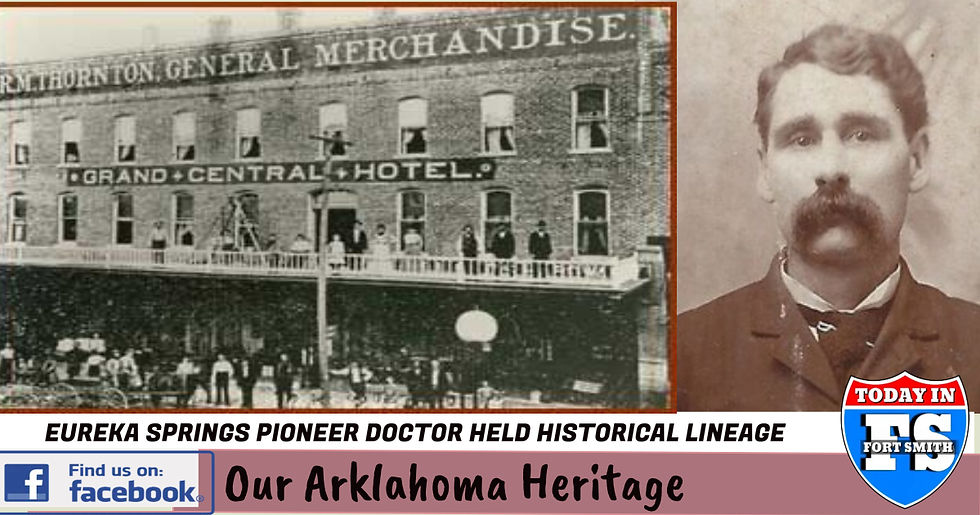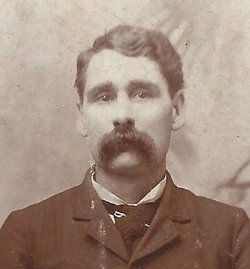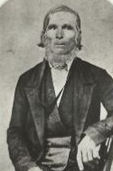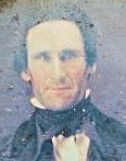Our Arklahoma Heritage: Doctor who practiced in Eureka Springs in late 1880s sprung from Revolutionary roots
- Dennis McCaslin

- Aug 23
- 3 min read



In the Ozark hills of northwest Arkansas, where the famed healing waters of Eureka Springs drew thousands in the late 19th century, the story of the Baxter family stands as a thread woven into both local and national history.
At its center is Dr. William Baxter, a physician who brought his Ohio roots to the Arkansas boomtown in the late 1800s.
His life and ancestry reflect a legacy of migration, service, and resilience that stretches back to America’s earliest conflicts.

The Baxter family traces its American beginnings to John Baxter (born c. 1740 in Scotland, died 1810 in Maryland), who served as a Patriot in the Maryland Militia during the Revolutionary War.
Enlisting in 1777 under Captain Joshua Rutledge, he joined the Maryland militia during a critical phase of the Revolutionary War. Muster rolls from that year confirm his service, placing him among the ranks of local men called to defend their territory and support the Continental Army.
Maryland’s strategic location made its militia essential for protecting supply routes and reinforcing Washington’s forces during the volatile Mid-Atlantic campaigns.
Throughout 1777, Rutledge’s company operated in contested regions of Maryland and southern Pennsylvania, conducting patrols, securing roads, and engaging in skirmishes against British foraging parties.

Though not part of the main battles, these actions were vital to the broader war effort, offering tactical support and disrupting enemy movements. Their efforts helped stabilize key areas as Washington prepared for major engagements like Brandywine and Germantown.
Militia service was often short-term, but its impact was lasting. By winter, Maryland units contributed to the survival of Washington’s army at Valley Forge, supplying reinforcements and resources during the harsh encampment.
His enlistment reflects the resilience and commitment of citizen-soldiers whose local defense efforts shaped the outcome of the war in ways often overlooked by traditional military histories.
After the war, John Baxter settled in Frederick County, Maryland, where he raised his family.

His son, Robert Baxter (1765–1832), born during the war years, later moved west into Ohio. Historical records describe Robert as a blacksmith and early landowner in what became Carroll County in that state.
His son, James Baxter Sr. (1775–1860), became one of the early settlers of Harrison Township, Carroll County. An obituary published in the Carroll Free Press in 1860 portrayed him as a steadfast community builder.
He and his wife, Mary Ann (1780–1845), are buried at Baxter’s Ridge Cemetery, a site named for the family.
By the mid-19th century, the Baxters were well established in Ohio. Dr. William’s father, James Baxter Jr. (1811–1897), remained in Carroll County during the Civil War, managing the family farm. While he himself did not serve due to his age, extended family members joined Union regiments from Ohio.

One branch of the family, the Coopers--Dr. William’s maternal line--saw direct involvement. His uncle, Samuel Cooper (1815–1864), enlisted in the 126th Ohio Infantry. Records indicate he fought in Tennessee and Georgia before dying of illness during the war.
Another relative, Thomas Baxter (1820–1863), served in the 4th Ohio Cavalry and died from wounds sustained at Stones River. These accounts, documented in state rosters and genealogical records, illustrate the family’s sacrifice during the conflict.
Born in 1852 in Carroll County, Ohio, William Baxter pursued medical training during the 1870s before relocating to Arkansas.
By the late 1880s, he had settled in Eureka Springs, a city rapidly growing after the discovery and promotion of its mineral springs. The town became a destination for those seeking cures, and physicians like Dr. Baxter were central to its development.

Dr. Baxter died in 1908 at the age of 56. He is buried at the Independent Order of Odd Fellows Cemetery in Eureka Springs. Though his grave marker has not survived, cemetery records confirm his interment there.
From Revolutionary War service in Maryland to frontier settlement in Ohio, and finally to the healing waters of Arkansas, the Baxters represent the migration and perseverance of American families across generations. Their presence remains in cemeteries like Baxter’s Ridge in Ohio and in the quiet resting place of Dr. William in Eureka Springs.
The story of the Baxters illustrates a family shaped by the nation’s defining moments—war, migration, and community building--and whose memory endures in the landscapes they helped settle.


